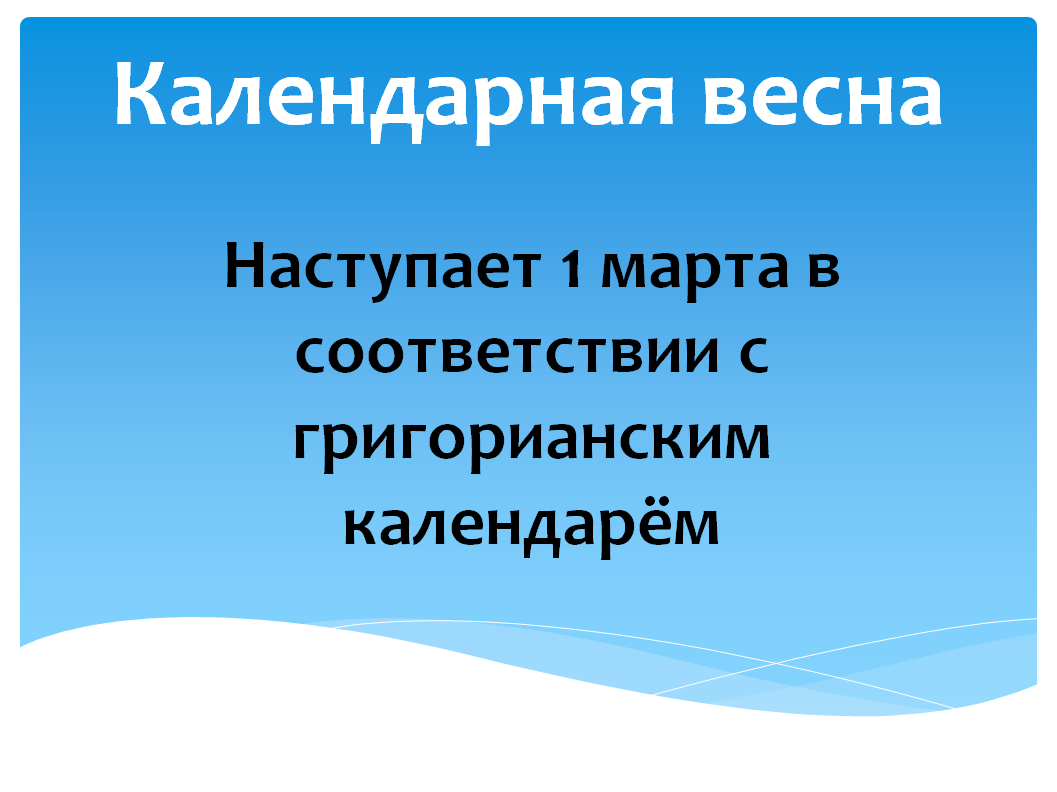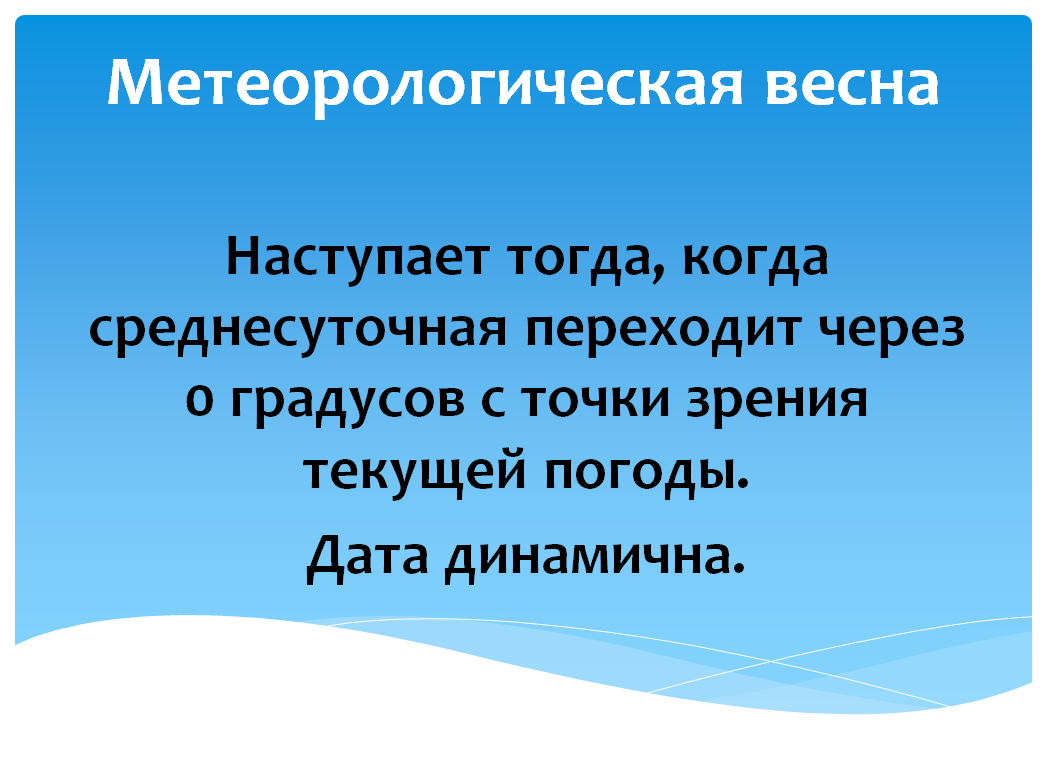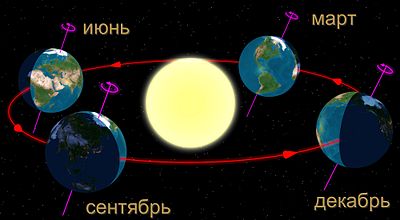The beginning of spring and not. Astronomical spring, or the day of the vernal equinox
Spring begins immediately after winter and ends with the advent of summer. But to determine what date spring begins is not at all easy. The fact is that in different fields of knowledge they use their own definition of spring. calendar spring is a transitional period. At this time, the daylight hours increase, the air temperature rises, living beings and plants become more active. The calendar spring consists of 3 months. March, April, May are the spring months of the Northern Hemisphere. In the South, spring begins in September and ends in November. IN real life spring does not obey him and in the southern regions comes earlier, and in the northern regions it is late. astronomical spring a term coined by astronomers. It comes into its own on the day when spring begins according to the Sun. It comes to the Northern Hemisphere on March 20 (21), on opposite side On Earth, this unique phenomenon is observed on September 22 (23). Astronomical spring ends on the day summer solstice. climate spring occurs when the average daily temperature steadily exceeds 0 degrees. IN Vologda region the transition of the average daily temperature through 0 degrees occurs in the first decade of April. the beginning phenological spring the period of snowmelt (the formation of thawed patches in the field) is considered. Spring ends with the onset of summer, which is determined by the flowering of wild rose. The cultural characteristics of the peoples of the world determine their timing of the arrival of spring. In Rus', since ancient times, the day of the meeting of spring was celebrated on March 22. It was called "Magpie". There was a belief that forty birds fly to Magpies, the magpie builds a nest and comes real spring. In addition, Maslenitsa is widely celebrated in Rus', the holiday of seeing off winter, which was later combined with church calendar and marks the beginning of Lent.
In Romania and Moldova, on March 1, it is customary to celebrate Martisor (the holiday of meeting spring). In honor of the holiday, it is customary to give each other small boutonnieres in the form of flowers, which are worn on clothes all month, and on March 31 they are removed and hung on trees. Holiday is born beautiful legend about the victory of spring over winter: on the first day of March, the beautiful Spring came to the edge of the forest and saw a snowdrop breaking out from under the snow in the thickets of blackthorn. She decided to help him and began to clear the ground around, freeing him from thorny branches. Winter saw this and was furious. Waving her hands, she called cold wind with snow to destroy the primrose. A weak flower drooped under the cruel wind. But spring covered the sprout with her hands and pricked herself with thorns. A drop of hot blood fell from her wounded hand, and the flower came to life. In Germany, they celebrate the beginning of spring in April, the Americans begin to prepare for its arrival in advance on February 2, Groundhog Day. People believe the predictions of groundhogs and believe that they can announce the approach of spring. Groundhog Day has its ancestors: even the ancient Romans "consulted" with animals, celebrating Hedgehog Day on February 2. In France, there is an unusual holiday, however, in part it is similar to our March 8 - Grandmother's Day. On this day, congratulations are accepted only by women aged 55 and older. The heroes of the occasion, slowly walking through the streets of the city, announcing the arrival of spring. In Japan, from the first of March to the end of April, hanami is held - a holiday for viewing cherry blossoms. Throughout Japan, hundreds of trees are covered in pale pink flowers. Holi, or the festival of colors, is held annually in India. dedicated to god love Kamadeva. It is also called the Bengali New Year and this event marks the arrival of spring. This year, the calendar spring on the territory of the Vologda Oblast will be marked by a thaw: Atlantic cyclones, together with precipitation, will bring warming, daytime temperatures will again be above zero. It is still too early to consider this the arrival of spring, since in the future more than once returns of cold will be noted.
Materials used to prepare the article: http://nimfa.ru, photo: https://www.look.
.
Forecaster of the department of the OGMO Rykovanova O.I.
And spring is- fake!
When does spring actually come in Russia? Myths about spring
The first misconception concerns the date of the beginning of spring. Of course, most firmly believe that spring comes on March 1st. Tell the people of Chukotka and Oymyakon about it. In Anadyr at this time, the daytime temperature fluctuates around -20 ... -25, and this is the norm for March 1, and in Oymyakon around -35 ... -40. Where is spring then? And before it is at least a month, and in Siberia and all two!

There is such a thing as a calendar, climatic, meteorological and astronomical spring. Oh how! So, it is the calendar spring that comes in the entire northern hemisphere on March 1, and it has nothing to do with the weather, birds and streams. But what exactly is spring?
Spring is the process of awakening nature after hibernation. And the launch of these processes is directly related to one key indicator - temperature.
March- spring month?
Another misconception concerns the first spring month- March. It has never been spring, March is still winter month. On greater territory Russia average temperature below zero. The rivers are covered with ice snow cover has not yet descended, there are frequent arctic incursions accompanied by intense snowfalls. March is a winter month. Spring it is only from the point of view of the calendar.
When did it start?
If March 1 cannot be taken as the date of the beginning of spring, then when does it begin? Each region has its own date and depends on the climate. There is a so-called climatic and meteorological spring. How are they different?
climate spring

It should be immediately noted that the date of the beginning of the climatic spring is static. It does not depend on the weather outside the window, but depends on the weather that has been over the past 30 years. It is this period of time that climatologists use to describe the climate. Climatic spring occurs when the average daily temperature passes through 0 degrees in positive side. As a rule, this is the average date, after which the snow melts rapidly, the opening of the rivers begins, and the vegetation processes start. Nature comes to life. The real spring is coming! In Moscow, for example, the start date of the climatic spring falls on March 20, and in Yakutsk on April 27. The difference is obvious!
But in some cases, winter is delayed and spring does not come even after the start date of climatic spring.
meteorological spring

The onset of this spring is directly related to the thermometer readings. Therefore, the date of the onset of meteorological spring is dynamic, and every year falls on different dates. Meteorological spring comes when the average daily temperature crosses the zero mark and holds steady for five or more days. For example, in 2015 in Moscow meteorological spring came already on February 20! Of course, in this case, the meteorological spring came earlier than the climatic one, so it can be considered early.
astronomical spring

It's even simpler here, as the name implies. Astronomical spring comes on the day spring equinox and most often this date falls on March 20. March 20 - the day of the onset of astronomical spring. At this time, the Earth is in such a position with respect to the Sun, when both hemispheres, from the equator to the poles, heat up relatively equally. This happens twice a year: on March 20 - on the day of the vernal equinox and on September 23 - on the day autumn equinox.
From March 20, the seasons change in the hemispheres, astronomical autumn begins in the Southern Hemisphere of the Earth, and astronomical spring begins in the Northern Hemisphere, which continues until the day of the summer solstice (June 21). After the day of the vernal equinox, spring warmth always comes, no matter how cold it was before.
Outcome
The question arises, what spring date should be taken as a standard, so as not to be mistaken? This is a climatic spring, the date of which depends on the climate of the region. Below is an indicative table for different cities of Russia.

The average timing of the onset of climatic spring in different cities Russia
When spring comes in St. Petersburg, Novosibirsk, Yekaterinburg, Nizhny Novgorod, Kazan,
Chelyabinsk, Omsk, Samara, Ufa, Rostov-on-Don, Krasnoyarsk, Perm, Oymyakon, Tiksi, Khabarovsk, Vladivostok, Magadan, Murmansk, Salekhard, Kurgan, Tyumen, Khatanga. When does spring come?
March 21 - the day of the onset of astronomical spring, it is also called the day of the vernal equinox. At this time, the Earth is in such a position in relation to the Sun, when both hemispheres, from the equator to the poles, heat up relatively equally. This happens twice a year: on March 21 - on the day of the spring equinox and on September 23 - on the day of the autumn equinox.
From March 21, the seasons change in the hemispheres, astronomical autumn begins in the Southern Hemisphere of the Earth, and astronomical spring begins in the Northern Hemisphere, which continues until the summer solstice (June 21). After the day of the vernal equinox, spring warmth always comes, no matter how cold it was before.
The ancient scientists of China, India, and Egypt knew very well about the days of the vernal equinox. In ancient times, the days of the vernal equinox were considered great holiday. Nature is reborn again, bears wake up, animals begin to lead more active image life, preparing for procreation.
In religion in old times The day of the spring equinox was also of no small importance. The date of the Easter holiday, which is celebrated every year in different time, was counted from the day of the vernal equinox as follows: March 21 - the first new moon - the first Sunday, which was considered a holiday.
It all started in 325 AD, when the Council of Nicaea took place, at which the Julian calendar was adopted for everything Christendom. By decree of the Council of Nicaea, the equinox had to "forever" fall precisely on March 21, as it was in the year of the council, but at the end of the 14th century. Christian church suddenly discovered that the spring equinox no longer coincides with March 21, and moreover, every 128 years it comes one more day earlier, and when the error was noticed, the difference was already 10 days: julian calendar the moment of the equinox was supposed to occur on March 21, but in reality it already occurred on March 11. This was pointed out by many astronomers, and the clergy more than once intended to carry out a reform, but each time it was postponed for different reasons. Finally, Pope Gregory XIII announced a competition for best project new calendar. The project of the Italian mathematician Lilio won. And in 1582, the pope issued a special bull, according to which the count of days was moved forward by 10 days and Friday after Thursday, October 4, 1582, it was prescribed to count not October 5, but October 15. This immediately corrected the error that had accumulated since the Council of Nicaea, and the spring equinox again fell on March 21.
Many peoples have kept the spring equinox as a holiday in the calendar. For example, in Farsi it is called Nowruz, which means "new day". Rooted in the traditions of the ancient farmers of the Middle East and Central Asia, the holiday has become an integral part of the culture of many peoples who profess Islam. In the CIS, it is celebrated as a national Tatars, Kazakhs, Bashkirs, Kyrgyz, Tajiks, Uzbeks and many other peoples. Navruz has been announced in a number of countries public holiday, and March 21 is a day off. In Japan, the day of the spring equinox is celebrated - Shunbun no hi. The week period beginning three days before the vernal equinox is called Higan. At this time, the Japanese visit the graves of their ancestors, and cherry blossoms bloom in the gardens.
In Russia, most of all they rejoice that the daylight hours will increase every minute and the long-awaited summer will come.
What day do you consider the first day of spring? What are the first days of summer, autumn and winter like for you?
The seasons are four periods into which the annual cycle is conditionally divided. The change of seasons is determined by the annual period of the planet's revolution around the Sun and the inclination of the Earth's axis of rotation relative to the orbital plane and, to a small extent, the ellipticity of the orbit.
Distinguish:
calendar seasons- in most countries of the world, the division of the year into four seasons, three calendar months in everyone.
Astronomical seasons, which are measured from the points of the solstice (summer, winter) and equinox (spring, autumn).
Phenological seasons. Phenology determines the duration and timing of the beginning of each climatic season in accordance with natural phenomena(using the concept of a season). Each season has its own weather and temperature conditions.
In mid-latitudes, a formal, calendar division of the year into four approximately equal periods is often used.
For example, in most countries of the northern hemisphere, the following dates for the beginning and end of the seasons are accepted:
IN southern hemisphere the following dates have been adopted:
Govrie is a rationalist by nature, tends to trust more exact sciences, and within the limits of the given question - astronomy, in particular. It would seem that it is difficult, divide the calendar into 4 equal parts - that's it for you exact dates the beginning and the end of the seasons!.. But it wasn't there!
From point of view official science, astronomically the seasons are separated by the moments of the summer solstice, autumnal equinox, winter solstice and the spring equinox.
The beginning of the astronomical seasons is taken as the moment of passage of the center of the Sun through the points of equinoxes and solstices. That is, from an astronomical point of view, spring does not begin at all on March 1.
astronomical spring- This is the period from the spring equinox (March 21) to the summer solstice (June 21). Its duration is approximately 92 days 20 hours and 12 minutes.
astronomical summer- This is the period from the summer solstice (June 21) to the autumn equinox (September 23). Its duration is approximately 93 days 14 hours and 24 minutes.
astronomical autumn lasts from the autumn equinox (September 23) to the winter solstice (December 22) for 89 days 18 hours and 42 minutes.
astronomical winter lasts for approximately 89 days and 30 minutes - from the winter solstice (December 22) to the spring equinox (March 21).

"And what's the catch?" - you ask.
With spring and autumn, astronomers decided very convincingly and elegantly. You can’t argue here, it’s true - spring begins on the day from which the duration of daylight hours begins to increase, and autumn, on the contrary, from the day when the duration of daylight hours begins to decrease.
And the catch is that winter even in the most European Europe and Asian Asias cannot start from December 22, and summer from June 21. December 1 as the conditional beginning of winter and June 1 as the beginning of summer are still all right, but June 21 and December 22, according to Govrie, cannot be considered the first days of these seasons.
Then, what - according to the phenological theory, every year the first day of spring, summer, autumn and winter should be considered different dates, depending on the average daily air temperature reached? Somehow, not human.
And here it comes in handy folk traditions and customs.
In Russian Orthodox culture considered the first day of summer Nicholas Day May 22, and the first day of winter is recognized Veil day, October 14.
In fact, both of these dates are Orthodox holidays, the first of which is associated with the veneration of St. Nicholas the Wonderworker, subsequently popularized in Western culture in the person of the Christmas Santa Claus, and the second - with the veneration Mother of God, Mother of God.
Among the people, May 22 is known as Nikolin's day and is considered an important agrarian date. On Nikola Veshny, the grass becomes juicy and tall. Horses and cattle were driven out to green pastures. "May will feed the horse." From Nikola begins the mass planting of the main food in peasant houses - potatoes. Blueberries, strawberries, forget-me-nots and bathing suits bloom. Mosquitoes appear from Nikola and summer begins.
In Rus', the feast of the Intercession has long been associated with the beginning of winter, and sayings have been dedicated to it: “On Pokrov, the earth is covered with snow, it is dressed with frost”, “On Pokrov, autumn is in the afternoon, and winter is winter in the afternoon.”
Govrie decided for himself: spring will start from March 21, summer - from May 22, autumn - from September 21, and winter - from October 14.
And for you, what days do spring, summer, autumn and winter begin?
What else to read
THE LAST NOTES
- Revenge of the signs of the Zodiac - a description of all signs How Taurus takes revenge
- “Dream Interpretation The child dreamed of what the Child is dreaming of in a dream. It means that a child had a dream in a dream
- Why dream of wanting a child - interpretation of sleep from dream books Why dream of wanting a child in a dream
- And the dawns here are quiet (story) And the dawns here are quiet short author
- The richest countries in Olympic gold
